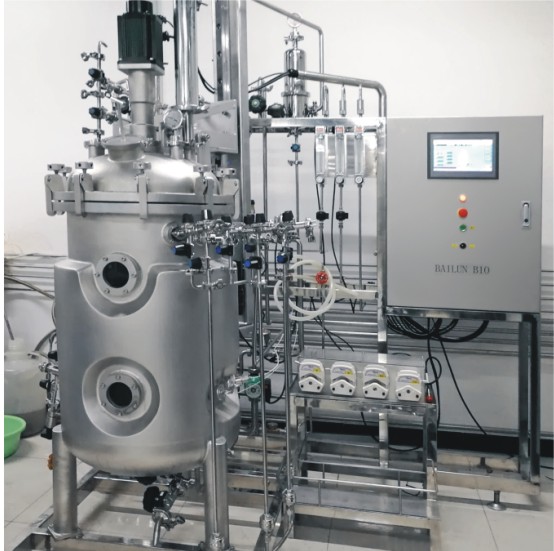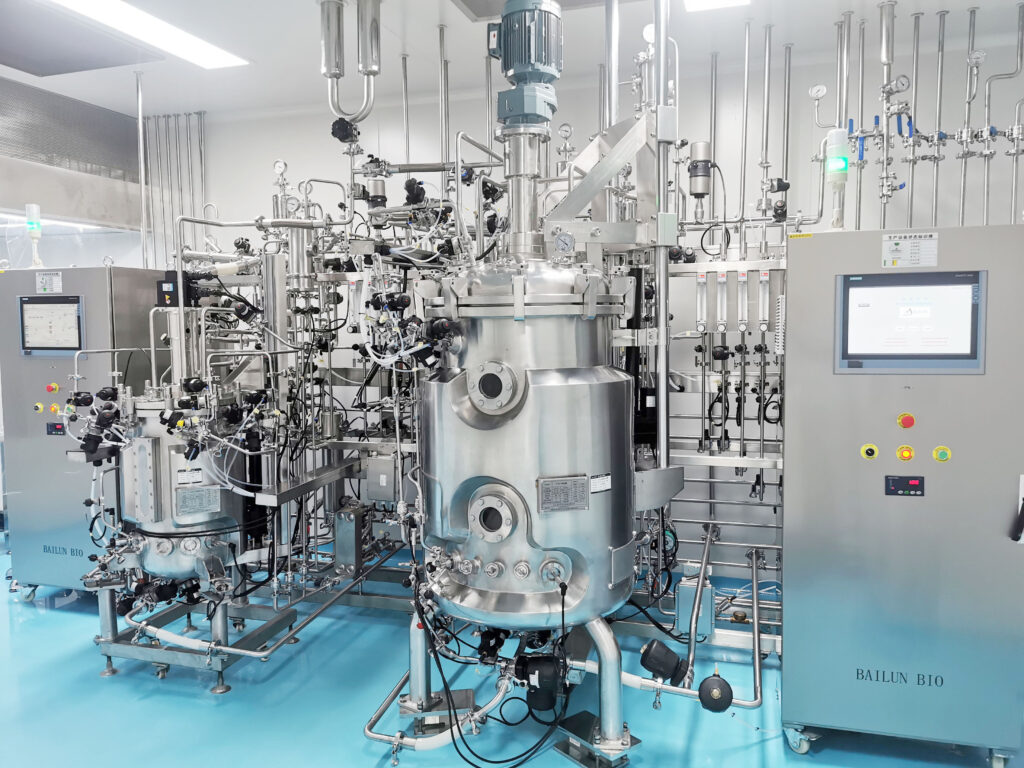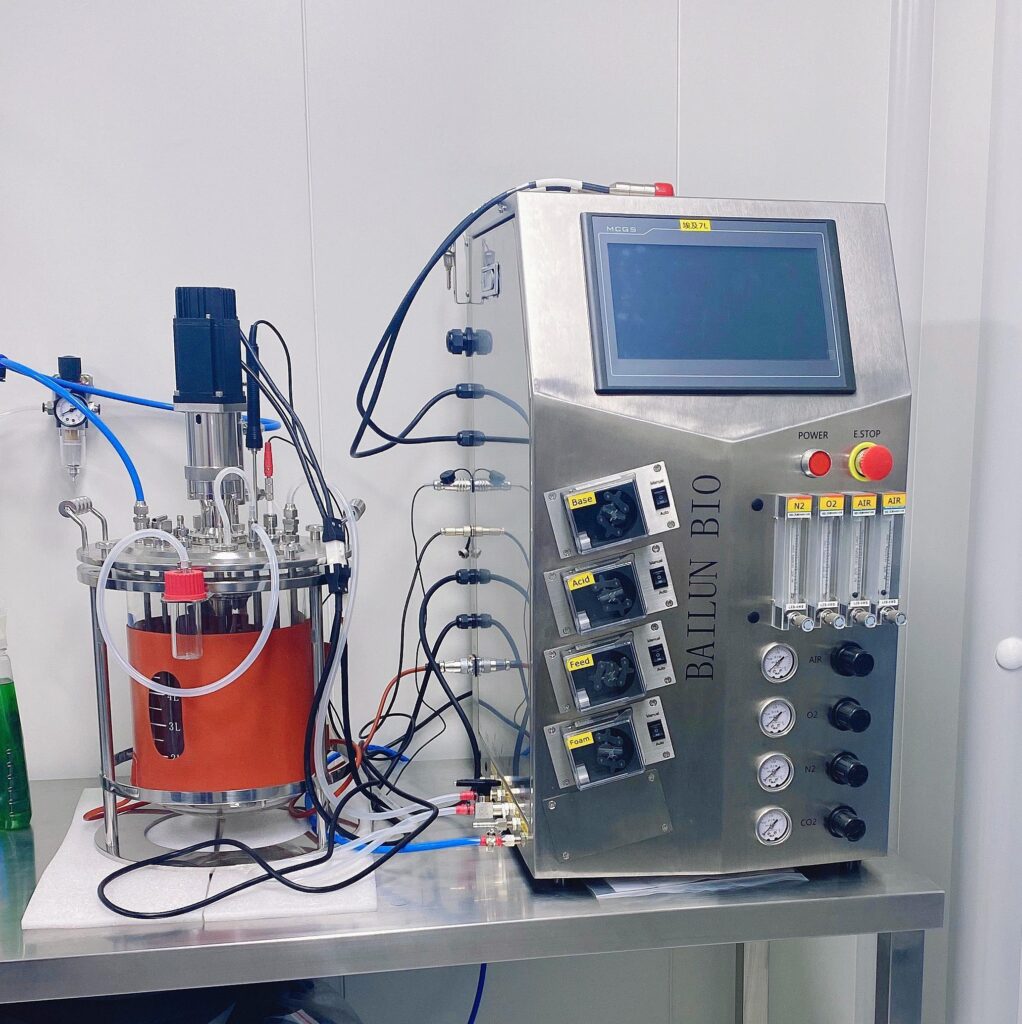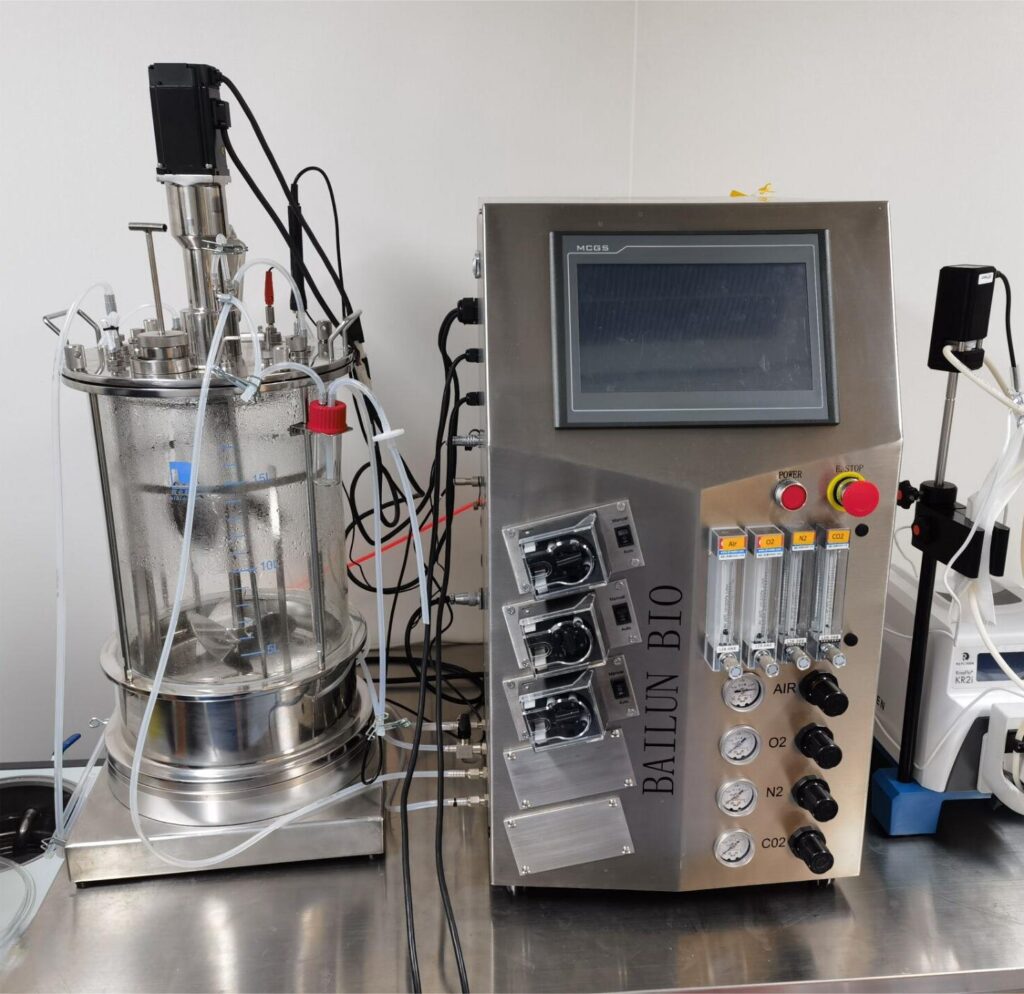The stirred tank bioreactor is one of the most common suspended cell culture bioreactors. It keeps the cells in the culture in a suspended state by mechanical stirring and provides sufficient oxygen and nutrients for cell growth.

The structure of the stirred tank bioreactor is relatively simple and easy to operate and maintain. However, the shear force and bubble impact caused by stirring on the cells may have an adverse effect on cell growth and product yield. Therefore, the stirring speed and gas intake need to be controlled in the stirred tank bioreactor to balance the mixing of the culture and the gas-liquid mass transfer process.
![]() Compared with stirred tank bioreactors, airlift bioreactors have better performance in the gas-liquid mass transfer process. Airlift bioreactors achieve gas-liquid mass transfer through the rising movement of bubbles, and the contact area between bubbles and liquid phase is greatly increased.
Compared with stirred tank bioreactors, airlift bioreactors have better performance in the gas-liquid mass transfer process. Airlift bioreactors achieve gas-liquid mass transfer through the rising movement of bubbles, and the contact area between bubbles and liquid phase is greatly increased.
In addition, the liquid flow generated by the rising movement of gas in the airlift bioreactor also helps to mix the suspended cells and reduce the differences in the local liquid environment. Therefore, the airlift bioreactor can provide better oxygen and nutrient supply while reducing the shear force on the suspended cells. However, the structure of the airlift bioreactor is relatively complex, and the operation and maintenance are difficult, requiring special gas devices and control systems.
In recent years, the application of single use bioreactors has gradually increased, becoming an emerging suspended cell culture bioreactor. Due to its relatively simple structure and operation, single use bioreactors reduce the workload of reactor cleaning and disinfection, can reduce the risk of cross infection, and save production costs.

Single use bioreactors also have good scalability and are convenient for mass production. However, single use bioreactors may have some problems in gas-liquid mass transfer and control, such as uneven supply of oxygen and nutrients, and difficulty in adjusting pH and temperature. Therefore, when using single use bioreactors, improvements and optimizations need to be made according to specific circumstances.![]()
![]()
In order to better meet the needs of suspended cell culture bioreactors, researchers have continuously explored and developed various new reactor designs in practice. For example, flexible wall suspended cell culture bioreactors can provide better isolation of liquid environment and shear force on cells by changing the wall material and structure of the culture chamber.
The membrane suspended cell culture bioreactor separates the liquid phase and gas phase through the support of the membrane, reducing the impact and shear force of bubbles on cells. These new reactor designs provide new ideas and directions for the development of suspended cell culture bioreactors.![]()
In summary, suspended cell culture bioreactors have an important position in the field of bioengineering, and different types of reactors differ in culture conditions, operation methods and design structures, each with its own advantages. With the continuous advancement of science and technology, various new reactor designs continue to emerge, providing more possibilities for the development of suspended cell culture bioreactors. Our research and application of suspended cell culture bioreactors will continue to deepen, helping the further development of biopharmaceuticals and bioprocesses.

The stirred tank bioreactor is a common suspended cell culture bioreactor, which is widely used in biopharmaceuticals, biofuels and other bioprocesses. It keeps the cells in the culture in a suspended state by mechanical stirring and provides sufficient oxygen and nutrients for cell growth. The basic structure of the stirred tank bioreactor includes a tank body, a stirring device, an air inlet device, a liquid level control device, a temperature control device, etc.
The tank body of the stirred tank bioreactor is usually made of stainless steel, which has high corrosion resistance and chemical stability. The stirring device of the stirred tank bioreactor is generally composed of a motor and a stirring paddle, and the intensity and speed of stirring can be controlled by adjusting the speed.
The air inlet device of the stirred tank bioreactor is used to inject gas, usually air or pure oxygen, into the culture medium to provide oxygen for cell growth. The liquid level control device of the stirred tank bioreactor is used to monitor and control the liquid level of the culture medium to maintain the appropriate volume and mixing degree of the culture medium. The temperature control device of the stirred tank bioreactor is used to maintain the temperature of the culture medium within an appropriate range.
In a stirred tank bioreactor, the suspension state of cells is usually achieved by the turbulent flow generated by the stirring device. The shape and stirring speed of the stirring device have an important influence on the suspension of cells and the mixing effect of the liquid. Generally speaking, in the process of suspended cell culture, a moderate stirring intensity is required to maintain the suspension state of cells, but too high a stirring speed may cause excessive shear force on the cells, which will have an adverse effect on the integrity and biological activity of the cells.
Therefore, when using a stirred tank bioreactor, it is necessary to determine the appropriate stirring speed according to the specific cell type and culture conditions.

Gas supply is also very important for cell growth and product synthesis. Oxygen is a necessary substrate for cell respiration and metabolism, while carbon dioxide is one of the products. Therefore, stirred tank bioreactors are usually equipped with appropriate gas supply systems to supply appropriate oxygen to the culture medium and control the carbon dioxide content. The control of gas supply rate and flow rate is very important for maintaining gas balance and mass transfer of the culture medium.
In addition to the supply of oxygen and nutrients, the pH value and temperature of the liquid are also important parameters that need to be controlled in cell culture. Stirred tank bioreactors can be equipped with appropriate pH and temperature control devices to maintain the stability of the culture medium. pH control is usually achieved by adding acid or alkali, and temperature control can be achieved by cooling or heating.
In suspension cell culture, stirred tank bioreactors have the following advantages and disadvantages:
Advantages of Stirred Tank Bioreactor:
- Even mixing: The stirred tank bioreactor mixes the cells, culture medium and gas in the culture medium evenly through the stirring device, so that the cells can fully contact the nutrients and oxygen in the culture medium, promote cell growth and the production of metabolites.
- Adjustable reaction conditions: By adjusting the stirring speed, temperature, pH value and other parameters, the reaction conditions in the cell culture process can be controlled to meet the growth and expression requirements of different cells.
- Easy to operate and control: The stirred tank bioreactor is simple in design and easy to operate. It can monitor and adjust various parameters of the culture medium, such as temperature, pH value and dissolved oxygen, in real time to ensure the stability and controllability of the culture process.
- Suitable for large-scale production: The stirred tank bioreactor can carry out large-scale suspension cell culture, which is suitable for industrial production and can improve production efficiency and output.
Disadvantages of Stirred Tank Bioreactor:
- Uneven gas-liquid mass transfer: The stirring in the stirred tank bioreactor will cause shear force and bubble generation of the liquid, which may lead to uneven oxygen mass transfer, resulting in insufficient oxygen supply to some cells, affecting cell growth and product quality.
- Difficulty in handling high-viscosity liquids: For high-viscosity culture fluids, stirred tank bioreactors may encounter problems of difficult stirring and high energy consumption.
- Avoid cell breakage: For some more fragile cells, the stirring force in the stirred tank bioreactor may cause cell breakage or damage, thereby affecting cell growth and yield.
Stirred tank bioreactors are also mainly used in suspended cell culture. The following are some of the main application scenarios:
- Cell growth: Stirred tank bioreactors are often used in the cell growth stage of the cell culture process. Through the stirring and ventilation system, sufficient nutrients and oxygen can be provided to the cells, and the cells can be kept in suspension to promote cell growth and reproduction.
- Protein expression: In protein expression, stirred tank bioreactors can be used in cell culture and protein expression processes. By regulating parameters such as stirring speed, temperature and nutrients, cell growth and protein expression levels can be optimized.
- Vaccine production: Stirred tank bioreactors are widely used in the vaccine production process. By optimizing stirring and culture conditions, the yield and quality of vaccines can be improved, and the stability of active ingredients in vaccines can be ensured.
- Antibiotic production: In the antibiotic production process, stirred tank bioreactors are used for the cultivation and fermentation of microorganisms. By stirring and controlling reaction temperature, pH value and other conditions, the growth rate of microbial strains and the yield of antibiotics can be increased.
- Cosmetic product production: Stirred tank bioreactors are used for mixing and reaction steps in the production of cosmetic products. By stirring and controlling reaction conditions, it is possible to ensure that the raw materials are fully mixed and the product quality is improved.
The application of stirred tank bioreactors in suspension cell culture can provide cells with a good growth environment and optimized reaction conditions to improve production efficiency and product quality.

